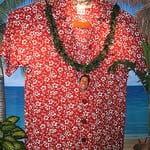Skift Take
Alfred Shaheen transformed Hawaiian shirts into a fashion must-have in the 1950s and boosted Honolulu’s economy by keeping all manufacturing on the island that inspired the design.
That Hawaiian shirt you wore on Friday for casual day? You can thank Alfred Shaheen for that.
Clothes may make the man, but Shaheen was the man who made the clothes — the fashionable ones created in Honolulu that elevated aloha attire to a new level of sophistication. In the 1950s, ’60s and ’70s, if you were wearing a Shaheen creation, you had the good goods.
Not sure what a Shaheen looks like? Imagine shirts and dresses that suggest various ethnic influences in rich (not loud) colors and luxurious fabrics with an attention to detail. One image that can get you started: Elvis Presley on the cover of “Blue Hawaii.” His shirt was among dozens and dozens of Shaheen designs that included both men’s and women’s wear.
“He traveled his team of ‘Shaheen craftsmen’ around the globe in search of inspiration, and they found it in Japanese lanterns and Tahitian flowers, in Hawaiian bark cloth and Chinese incense sticks,” said Noelle M.K.Y. Kahanu, director of community affairs for the Bernice Pauahi Bishop Museum in Honolulu. “He opened the eyes of the world to beauty beyond their horizons.”
The Bishop Museum in Honolulu will celebrate Shaheen’s vision with an exhibit Nov. 10-Feb. 4. “HI Fashion: The Legacy of Alfred Shaheen” will include more than 200 works in the 5,000-square-foot gallery in the Bishop’s Castle Memorial Building.
“Works” is really too sterile a word to describe the clothing that became not only a symbol of the good life in Hawaii but also embodied the genius of this aeronautical engineer and pilot who took the Hawaiian garment industry from its infancy to full-fledged adulthood.
By innovating and taking risks, he also changed the Hawaiian shirt from a novelty to an industry, said Rachel Weingarten, a New York trends and style expert whose interest in all things midcentury led her to write “Hello Gorgeous: Beauty Products in America, ’40s-’60s.”
He took the look from “chintzy — something you looked at and laughed at and that was uncomfortable outside of Hawaii — to a thing of beauty,” she said. “People who are into vintage clothing glow when they hear” the Shaheen name, she said.
Shaheen had the clothing industry in his blood. His parents, Lebanese immigrants, moved from New Jersey, where he was born, to Honolulu and were in the custom garment-making business in the 1930s. Young Shaheen returned to the mainland to attend Whittier College and graduated with a degree in aeronautical engineering. In World War II, he flew 85 missions over Germany, Italy and France.
After the war, Shaheen “caught that wave of hopeful new beginnings,” said his daughter, Camille Shaheen-Tunberg. He branched off from the family business, using seamstresses trained by his mother. He soon realized that creating his own fabrics gave him the inventory control that allowed him to produce more of what sold well.
He built much of the equipment for this manufacturing from wood, which, when exposed to acid-suffused dyes, often fell apart and had to be rebuilt at night. (Ultimately, he was able to afford metals that withstood chemicals.) In less than a decade, the business of producing clothing that reflected the renewed optimism of Hawaii was burgeoning.
“It was just a magical time,” his daughter recalled. She was 10 or 11, she said, when she began working in his factory, where she found the workers and the environment warm and welcoming. “It had to be the aloha spirit,” she said.
And, perhaps, Shaheen’s entrepreneurial spirit, which was integral to his building a 23,000-square-foot factory in Honolulu and to a string of Shaheen’s of Honolulu shops and Shaheen East Meets West boutiques in department stores across the country and the world.
By the late ’80s, increasing labor costs and interest rates coupled with the stress of four decades of running a business prompted Shaheen to close up shop and head back to the mainland. He died Dec. 22, 2008.
Today original Shaheens, found on EBay and coveted by collectors, sell for hundreds and even thousands of dollars.
The Bishop exhibit, which grew out of a San Jose Museum of Quilts & Textiles exhibit in 2010, will be more than double the size of the California exhibit. The new show will also include a section devoted to artists who have been inspired by Shaheen, whose influence you undoubtedly will sense on your next casual Friday.
“He is,” Weingarten said, “very cool.”
(c)2012 the Los Angeles Times. Distributed by MCT Information Services.
![]()
The Daily Newsletter
Our daily coverage of the global travel industry. Written by editors and analysts from across Skift’s brands.
Have a confidential tip for Skift? Get in touch

